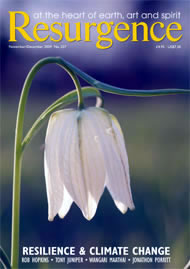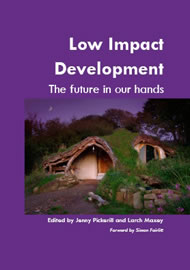Copenhagen, Denmark conjures many images of environmental sustainability: from the technologically pioneering wind energy programmes which announce the country’s environmental credentials to the visitor unsustainably approaching Kastrup airport, to the alternative community of Christiania which pioneered eco-building and waste minimisation from the 1970s. At dusk, lit by wood-burning braziers, Christiania evokes a post-apocalyptic vision of how we might be living later in the 21st century. World leaders will gather in Copenhagen in December 2009 to agree, or challenge, a consensus of how we can collectively achieve the drastic and immediate cuts in carbon and other greenhouse-gas emissions needed to avoid large-scale natural impacts and human disasters wrought by unabated climate change.
The consequences of failing to agree how to achieve a minimum 80% reduction in 1990 levels of carbon emission by 2050, and 30% by 2020, are life threatening. However, the overwhelming impression from natural and physical scientists, social scientists, technologists and policy advisers is that those reductions, if achieved fairly, with sensitivity to existing inequalities and whilst maximising technological innovations, have the potential to create a better life for us all. And rather than appearing as a barrier to environmental innovation and behaviour change, the economic recession should be seen as a stimulus for rethinking conventional growth imperatives and investing in constructive skills (for example, green technologies), and as an encouragement to us all to envisage a more meaningful, less consumer-driven lifestyle.
Low Impact Development promises “innovative solutions for the environmental, social and economic challenges of the 21st century” through low-impact development (LID). Representing the outcome of the Autonomous Geographies research project, funded by the Economic and Social Research Council and to which the editors contributed, the project and the book illustrate a gathering momentum within academia for radical social engagement. The activist-academic Larch Maxey has been at the forefront of this call for a decade now, and Low Impact Development shows how environmental and social action and academic activity can work to support each other. The purpose of the book, however, is to demonstrate to groups thinking of creating LIDs how they can best negotiate the labyrinthine planning procedures in order to set them up.
Contributors – all of whom are members of various rural low-impact developments – write about the benefits of building their own homes and communities according to stringent ecological principles, using local materials and maximising energy efficiency, with an emphasis on passive embodied energy. This becomes the hub of a socially and environmentally sustainable lifestyle in which residents work close to home, minimise their use of private transport, and grow their own food. They have all, however, come into conflict with local planning authorities, often because the LIDs are proposed, or more likely already built (this is guerrilla construction territory), on agricultural land. The examples highlight the inconsistency of planning decisions: some are refused permission outright, while others are retrospectively granted short-term planning permission (commonly three to five years – it is not clear what happens, or is expect to happen, when this period expires). The central, most extensive example, the Lammas community in Wales, is an exception to the other case studies in that the detailed plans are being submitted for planning permission prior to the laying of the metaphorical foundation-stone.
Together, these case studies provide a practical guide to negotiating UK planning systems for those thinking of setting up an LID. The commitment and enthusiasm that shine from these pages are inspiring. Today, over 10,000 people in the UK live in LIDs, mostly housing less than twenty people each. Through their ‘do-it-yourself’ nature they are cheap (some costing £3,000 in materials, to which needs to be added the cost of the land), and thereby represent good value for families keen to be self-sufficient, or choosing to minimise their participation in the cash economy. Their concentration in South West England and Wales suggests a regional geography of planning tolerance, or foresight.
The editors recognise that urban LIDs are not well represented in their case studies, and in a country where around 80% of people live in urban areas, there is a desperate need to learn how to make urban developments more low-impact (see for example www.bioregional.org.uk whose collaboration with the London Borough of Sutton suggests that there are urban boroughs sympathetic to LID). Urban living offers us greater potential to reduce commuting and make economies of scale (co-operative food-buying, for example), and the increased popularity of urban food-growing and car pooling indicates that there are lower-impact ways of living in towns and cities: just as well, as the countryside surely could not accommodate us all if we opted for the rural LID lifestyle.
This book delivers ideas, inspiration and practical advice to potential low-impact developers, disproportionate to its modest size and price. Implicitly it demonstrates how alliances between academics and the communities in which they live and work can be productive and radical. It can also offer support to planners who are looking for ways to push forward the sustainability agenda.
Susan Buckingham is Director of the Centre for Human Geography, Brunel University and Chair of the Women’s Environmental Network.







